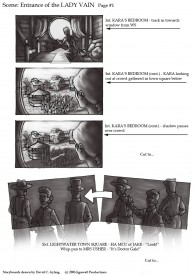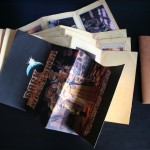Working on my Stop/Eject mood reel for FilmWorks last week got me thinking about the various methods with which a director can convey his vision for a film during the development process. Here are the ways I’ve used over the years, and the pros and cons of each.
The first ones are all static images, so they can be printed out and thus viewed without the need for any technology (no worries about whether the recipient will be able to open this particular file format) but are also small enough to be emailed. They’ll never grab someone’s attention as much as a moving image, but take less time to absorb and can produce an instant reaction.
If you have the skills or know someone who does, high quality CONCEPT ART can dazzle and excite. Choose dramatic moments and give the artist guidance on the colour palette and lighting you’re after.


You wouldn’t get STORYBOARDS out at an initial pitch, but they’ll impress at a second or third meeting. They show you’ve thought carefully about the script and how you’re going to put it on screen. This is particularly valuable if you have complex action or FX sequences. Beware that if the person you’re pitching to thinks the script needs more work, they’ll see storyboards as jumping the gun. Get the script right first.
A MOOD BOARD is a scrapbook or montage of images from films and/or other artforms that represent the tone and style of your piece. Less skill is required to make one of these than concept art or storyboards, and although as a creative person you may balk at the implication that your film is unoriginal, execs will find it very useful to compare your project to previous ones. If you use images from a film that did poor box office, again expect tough questions about why your movie won’t fail too.

A variation on this is a BOOKLET which might contain some of the above, plus photos and biogs of attached or wish-list actors, a synopsis, a director’s statement and maybe even an outline budget. Ian Tomlinson, The Dark Side of the Earth’s incredibly talented production designer, came up with the period-style leaflets pictured at left to promote the project. In one of my Cannes video blogs you can see a bit of these leaflets. (Sadly they’re now all gone and they got quite time-consuming and expensive to produce.)
Now we’ll look at moving images. Nowadays these aren’t prohibitively expensive to produce, and can be distributed for next-to-nothing via the internet – but beware of techy problems on the other end. Even YouTube doesn’t always work. If the person you’re sending it to can’t open it, they’ll probably give up and move onto something else, perhaps without even telling you why. Frankly I reckon you’re always safer with a DVD. Playing it off a laptop, tablet computer or iPhone in a meeting is a bad idea. Execs are narrow-minded and will see your project as a cheap YouTube video rather than a big, cinematic venture. Plus the sound will be awful. In another of my Cannes vlogs I discussed the dilemma of whether it’s better to show your pilot with poor picture and sound or not at all.
A MOOD REEL or RIP REEL is a moving version of the mood board or scrapbook. Ripping all those DVDs and YouTube clips can be a technical nightmare, but if done well it can be very useful. Here’s one for a very different vision of The Hunger Games by director Kevin Tancharoen. The accompanying interview on Slashfilm.com is also well worth a read.
Beware that many of the above materials will start giving the recipient thoughts about the budget. If your materials make it look like your vision will be expensive, be prepared to answer tough questions about that.
TEASER TRAILERS can be very useful for raising crowd-funding, but my feeling is that they’re not great for attracting conventional financing. Unless you’re going to chuck a hell of a lot of money at it and get an experienced trailer editor to cut it, the danger that a teaser trailer will look amateur and backfire is significant. You’d be better off with a rip reel.
PILOTS can also backfire. You can’t shoot it on a DSLR with a few hundred quid, then screen it at your pitch meeting and say, “The film will look like this, only better.” You have to shoot it with the production values you want the full film to have. That’s why my pilot for The Dark Side of the Earth was shot on 35mm anamorphic, and why we insist that anyone wanting to view it attends a screening of the print, rather than watching a crappy little quicktime or even a DVD. When you’re in that darkened screening room with the 5.1 track rumbling away and the image looking jaw-droppingly beautiful, only then are you doing your film-to-be justice.
Consider making a stand-alone SHORT FILM instead. My greatest regret with the Dark Side pilot is that we didn’t do this; we just took a couple of scenes from the middle of the screenplay and added an introductory voiceover and concept art montage to explain the story so far. It’s far and away my best work, but no-one’s seen it! If only I could have entered it into film festivals. Even if that hadn’t helped get the feature funded, it would have been great exposure for me and perhaps could have led to another of my projects getting made.
Another thing I tried for Dark Side before making the pilot was PREVIZ. These are filmed or animated storyboards, normally created once a project is greenlit to help plan and budget for FX, but they may also have value as part of a pitch, particularly if you want to prove you’re on top of how the FX will be achieved. The Dark Sides previz was shot with action figures and cardboard models and I’d certainly never screen them in a pitch meeting; I did them mainly for my own benefit. If they’re for a pitch, get a good CG animator on the case.
Check out The Dark Side of the Earth: Previsualisation playlist on YouTube for more of these.
Finally, I once read about a filmmaker who created an AUDIO PITCH consisting of her own voice narrating the synopsis, mixed with music and sound effects. Whatever technology and skills you can access to best get your vision across, that’s what you’ve got to do. But remember, it has to be top quality or you’re just shooting yourself in the foot.
What methods have you used to get your vision across?